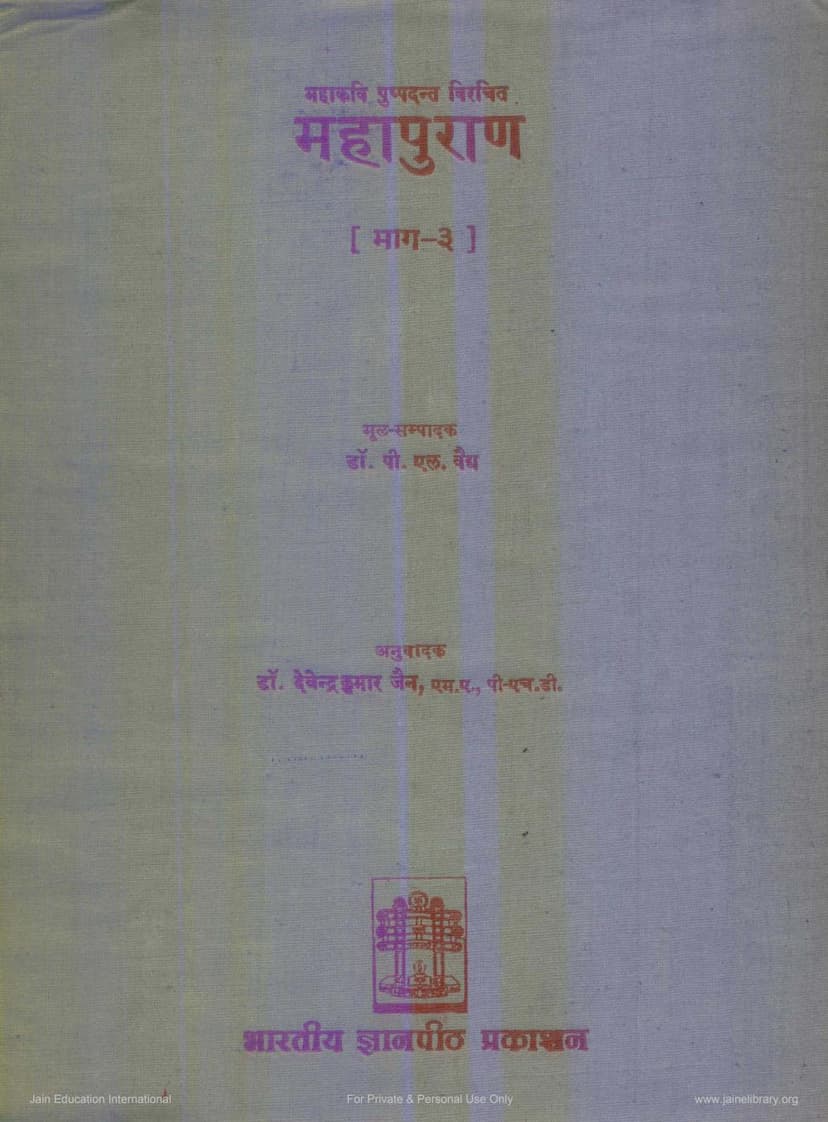Mahapurana Part 3
Added to library: September 2, 2025

Summary
This document is the third volume of the Mahapurana, a significant Jain text authored by Mahakavi Pushpadanta. It covers the biographies of the Tirthankaras from Ajitanatha to Mallinatha, spanning Sandhis 37 to 67. The book includes a Hindi translation, introduction, and index, with Dr. P. L. Vaidya as the chief editor and Dr. Devendra Kumar Jain as the translator. The publication is from Bharatiya Gyanpith, dated 1981.
The Mahapurana is a poetic narrative that delves into the lives of the great souls (Mahapurushas) in Jain tradition, including Tirthankaras, Chakravartins, Baladevas, Vasudevas, and Prativāsudevas. This particular volume focuses on the lives and events associated with Tirthankaras Ajitanatha, Sambhanatha, Abhinandana, Sumatinatha, Padmaprabha, Suparshvanatha, Chandraprabha, Suvidhi (Pushpadanta), Shitalanatha, Shreyamsa, Vasupujya, Vimala, Ananta, Dharma, Shanti, Kunthu, Ara, and Mallinatha. It also details the lineages of the Chakravartins, Baladevas, Vasudevas, and Prativāsudevas who lived during their respective eras.
The text meticulously describes the auspicious births, significant events in their lives, their renunciations, spiritual practices, attainments of Kevala Jnana (omniscience), and eventual Nirvana. Pushpadanta's poetic genius is evident in his descriptions of celestial events, the beauty of the characters, and the philosophical tenets presented. The Mahapurana serves as a rich source for understanding Jain cosmology, mythology, and the path to liberation as expounded by the Tirthankaras. The work highlights the cyclical nature of time, the transmigration of souls, and the ultimate goal of achieving Moksha (liberation) through righteousness, penance, and detachment.
The translator's preface emphasizes the importance of viewing Indian languages, from Sanskrit and Prakrit to modern Indian languages, as a continuous flow, highlighting the value of Mahapurana as a poetic and historical document for understanding the development of Shramanic culture and its critical significance for the study of broader Indian culture. The preface also reflects on the unfortunate decade for Apabhramsa language and literature due to the passing of many scholars and patrons.
The detailed introduction by Dr. P. L. Vaidya provides a critical apparatus based on three manuscripts (K, A, and P) and Prabhachandra's Tippana, discussing their descriptions and collations. The summary of contents offers a chapter-by-chapter overview of the lives narrated, including their previous births and key events. The appendices mentioned in the introduction likely contain tables of iconographical information, details of previous lives, lists of Ganadharas, Chakravartins, and sets of Baladevas, Vasudevas, and Prati-Vasudevas, drawing information from Jinadatta's Adipurana, Gunabhadra's Uttarapurana, and Pushpadanta's Mahapurana itself.
The translator's note at the end expresses gratitude to the Bharatiya Jnanpith trustees and editors for their support and acknowledges the challenges of translating such a language as Apabhramsa, especially when dealing with the brevity and poetic license of the original text. It also includes an appeal to scholars to bring to notice any inaccuracies or deficiencies in the publication.